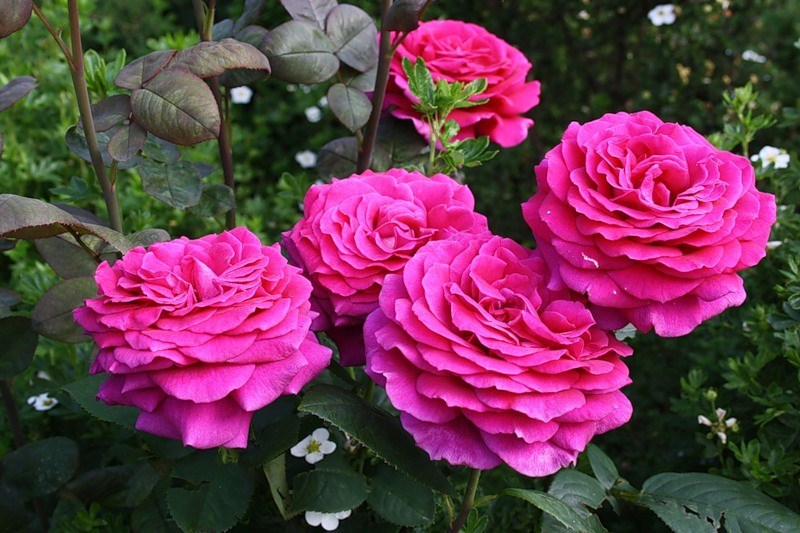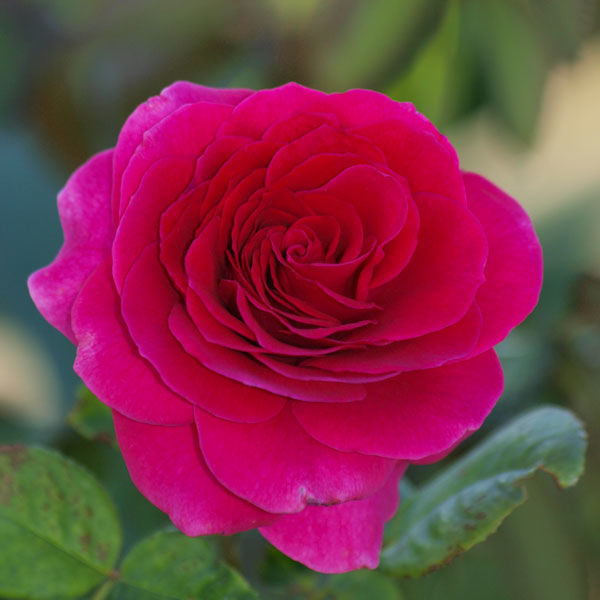Content:
Big Purple hybrid tea rose is renowned for its unique beauty and wonderful aroma. It has huge buds and bright color. The purple rose is often grown in greenhouses as it stands in a cut bouquet for a long time.
General information about the rose Big purple (Big purple)
Rosa Big Purple is one of the most beautiful hybrid tea varieties. Its buds are deep red, with a predominantly purple hue. They are large and terry, have a beautiful shape. The flower can have up to 45 petals. The buds have a strong pleasant aroma. One of the disadvantages of a rose is that it does not produce too many buds. There are many of them at the beginning of flowering, and by the end of August it becomes much less. The leaves of the rose are large, grayish-green in color.
Another beautiful variety of hybrid tea varieties is the Ecuador Deep Purple rose. It has an unusual color scheme. Being two-tone, the Ecuador Deep Pearl rose strikes with the beauty of raspberry and lilac shades. Light and pale pink flower petals are framed in a bright crimson or purple border. The bud is half-open, double and lush.
The history of the creation of the hybrid tea rose Big Purple
The amazingly beautiful Big Purple was created not by an experienced gardener, but by an ordinary person for whom growing roses was a favorite pastime. That man was Pat Stevens, secretary of the New Zealand Rose Society. Once he had the idea to make the idea of growing a beautiful lush flower, the image of which he invented himself, come to life. It took a long time for the first Big Purple to bloom in his garden. It was 1985 in New Zealand. Very soon, the variety began to enjoy world popularity, becoming famous for its amazing beauty. In Canada in 1999, the Big Purple rose was named "Best Purple Rose" at the show.
Description of the Big Purple rose and its features
Rose Big Purple has large, dense and double buds up to 16 cm in diameter. Each bud contains about 45-50 petals. It has the shape of a bowl, which becomes flat when the flower opens. Due to its size and color, Big Purple is unlike any other variety. The color of the buds becomes different with the change of season.
With the onset of cool days and in the process of wilting, the bud acquires a maroon, almost purple color. A flower growing in the shade will have the same color immediately. The flower leaves are dark green in color.
The purple rose bush can reach a height of 1.4 meters and a width of 75 centimeters. Only one bud appears on one stem of a flower. The rose stands in the cut for a long time.
Rose Big Purpl blooms throughout the summer period until autumn. It is resistant to disease and the cold season.
One of the great things about Big Purple is that it blooms continuously. It produces most of the buds in spring and early summer. At the end of August, the number of flowers is reduced by half, and sometimes by three times. The buds are the most beautiful when they open. After full disclosure, the purple rose loses its beauty a little, but still remains attractive, endowing with a strong pink scent.
Buds appear singly on long shoots. The bush is erect and vigorous.
If it is grown in areas of central Russia, then it needs to be covered for the winter. But even at a temperature of no higher than −7 ° C, there is no need to rush to cover the rose. The rose tolerates this temperature well and it has the opportunity to better prepare for the winter period. Before covering the roses, the stems are cut off, and the base of the bush is covered with soil. Ordinary soil from the garden, humus, compost are best suited for hilling.
Spruce branches are the best winter shelter for a rose. It is placed on top of the flower, as well as between the bushes.
Rules for the care of Purple rose
Propagated by cuttings. Only through such reproduction can the flower retain all the properties of the variety. After the young and healthy rose bushes bloom for the first time, cuttings are made from them.
The purple rose loves warmth, so it needs to be grown in a sunny area. However, after lunch, the flower should be in partial shade, since burns may occur on the rosebuds due to the scorching sun.
The place where the plant will be planted determines the state of its health. Placing the rose in a well-ventilated place avoids many diseases. It is not recommended to grow in low places, as cold air will stagnate there and the flower will hurt.
It is not recommended to grow this variety in regions with an abundance of rain, since dampness affects its flowers very badly. After the rains, the petals droop. Therefore, a dry climate is more suitable for this flower.
It is recommended to plant this type of rose in the middle lane and more northern regions in April or May. In the fall, you can also plant a plant, but this must be done as quickly as possible so that the flower has time to let the roots. To plant a plant, they make a hole 60 cm deep. Drainage is poured at the bottom of the hole - small pebbles, crushed stone or gravel, at least 10 cm thick. On top of it, ground is laid at a height of at least 10 cm in the form of a dome. Before planting a seedling, it is placed in a special solution for a day, which stimulates the growth of roots.
If the roots are too long or damaged, then they must be removed with pruning shears to the part that is healthy.
For good growth and flowering, Big Ash rose requires fertile soil, well saturated with air.
Sand beds are also not suitable for planting. Since water easily passes through the sand and moisture does not linger around the plant. To improve such flower beds, they add clay soil along with humus, compost from peat or manure, turf soil.
The soil with pH = 5.6-6.5 is favorable.
Caring for a plant involves constant loosening of the earth, removing weeds, feeding, preventing diseases, and pruning.
Rose Big Purple is highly resistant to fungal diseases. However, weak plants can get sick with powdery mildew and black spot. It is necessary to process the flower with special means during the season.
Flower feeding is done in spring and summer. Phosphorus is added to the soil in spring, and potassium is added in summer.
Despite the fact that Big Purple rose is drought tolerant, watering is a must for it, especially in hot and dry weather. Plants are watered with warm water, 15-20 liters per one bush twice in 7 days in dry and warm weather. The flower is watered less often at the end of August, and at the beginning of September, irrigation is completely stopped.
It is also important to determine what kind of pruning needs to be done, which contributes to the formation of a bush or an early and lush flowering of a rose. Pruning can be strong, medium and low. In the spring, heavy pruning is carried out for old seedlings, as well as for newly planted seedlings. With this pruning, 2-4 buds are left on the shoots. Medium pruning promotes early flowering and makes the flower even more beautiful. With this pruning, 5-7 buds remain on the shoots. To remove flowers that have withered, weak pruning is used in the summer.
In autumn, they carry out sanitary pruning: they cut off diseased shoots and thin out bushes that are heavily overgrown. Summer - to regulate flowering: remove flowers that have already bloomed along with the upper part of the shoot.
Advantages and disadvantages of the variety in comparison with other varieties
The benefits include:
- large, double flowers of excellent shape with a bright color;
- flowering continuity;
- unusual delicious fruity aroma;
- high resistance to fungal diseases;
- unpretentious cultivation.
Among the disadvantages of Big Purple are:
- there are never many buds;
- instability to disease;
- after a while the bush turns into too "long-legged", and the lower parts of the shoots are bare;
- flowers are beautiful only when the flower blooms, after which they look untidy;
- the flower does not tolerate rainy weather.
Observing all the rules of agricultural technology, you can grow a beautiful and abundantly flowering plant.















